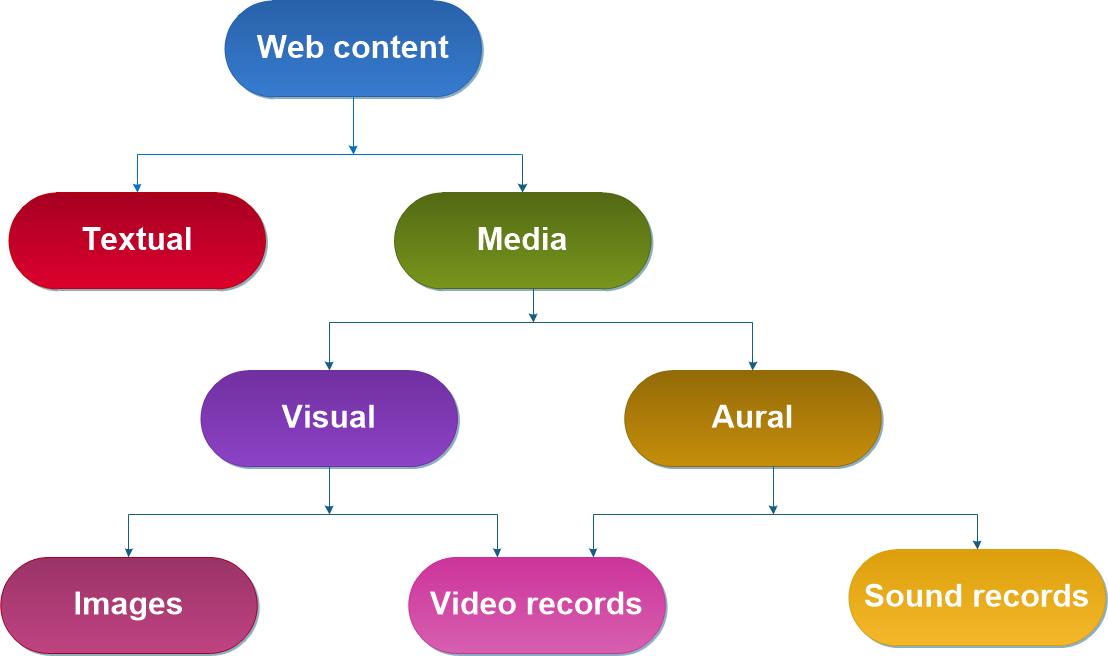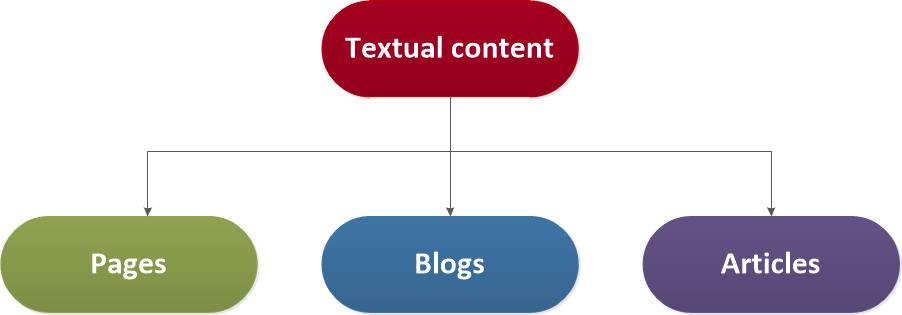Website content is the reason people come to your website, so content is the king of your website. Websites may have textual, visual, and aural content. The visual and aural content on sites is delivered by multimedia. Multimedia includes animation, images, sound, video, and any other content that isn't the text.

The textual content is contained in products and information pages, blogs, and articles; the dominant is the “page” concept composed of "html" content.

In spite of the fact that there are many ways to deliver information on a website, search engines are still text-based. If your website has images, graphics, animation, videos, flash, or other not textual files, they look pretty for users, but Googlebot doesn’t know what to do with them as read-only regular text. When Googlebot visits your website, it wants to see paragraphs, sentences, and words. So, the more you say on your website in organic text, the better your site looks for Google.
Writing for the Web differs from writing for print. Most Web users are searching for specific information or answers to their questions. Usually, website visitors don't stay long on one page. When users visit your website, they want quick and easy-to-understand website content and to find the information they are interested in. You should create quality textual web content as it promises more traffic, less bounce rate, and higher convergences. Before starting to write, define your goals and consider your audience. Analytics software can help you to get a better picture of your website's typical visitors and your potential customers. Interesting sites increase their recognition on their own. To please both the search engines and potential customers, you need to offer your users compelling and useful content optimized for search engines. Improving a website's content should be a priority, regardless of the type of the website.
Users enjoy the content that is well-written and easy to follow. Regardless of age, cultural background, education, attitudes, and reading level, people prefer easily understandable information. Write your content for readers, not for professionals. Keep your sentences short, but not choppy. Especially, this is important for the first few sentences of text. If visitors have difficulty at the beginning, they may stop reading and leave your website.
Avoid writing text with many spelling and grammatical mistakes.
Organize your content so visitors have a good sense of where one content topic ends and another begins. Use a clear topic sentence at the beginning of each paragraph. Breaking your content up into logical pieces helps users find the content they want faster. Moreover, it is recommended to write one topic per page.
Avoid adding large amounts of text onto a page without a paragraph, subheading, or layout separation
To get the visitor's attention, place the most important information first and the least important information last. Many users read only the first few words on a page or paragraph. If they think the content is interesting and/or helpful, they may keep reading; in other cases, they will go to a different page or leave your website.
People expect to see new information when visiting your website. Fresh content also helps lead your site to a higher search engine ranking draws more traffic to your website and helps attract customers. Moreover, it is recommended to display the date the site was last updated or in other words, the content was added or modified.
Search engine optimization is very important to get readers, but if your content is obviously geared towards the search engines you might quickly lose your readers. Consider your audience, its needs, and expectations; audience awareness is one of the main keys to writing effective web content. As to search engines, content with more words is likely preferred over short superficial texts. The more information you give on your website in the organic text the better your site looks for search engines.
Avoid embedding text in images for textual content, as search engines can't read it.
In other words, your website’s content needs to be original not duplicated from anywhere else. New content will not only keep your existing visitor coming back, but also bring in new visitors. Google uses different algorithms to determine sites with the highest quality content to provide each customer with websites that best match the user’s request, and unique content plays one of the key roles in search rankings. While unique content can improve a website’s search ranking, duplicate content can decrease it as search algorithms rate websites with unique content highly and vice versa penalizing websites for posting duplicate content.
Avoid copying existing content and placing content that will bring a little extra value to users. With more web pages your site has better, but each page's content must be exclusive.
Think about the words that a user might use to find a piece of your content. Use those words in your text as having keywords appear more than any other words likely acts as a relevancy signal. But, make sure that your content sounds natural and is pleasing to readers. Remember, now Google Hummingbird welcomes long-tail keywords.
Avoid inserting numerous unnecessary keywords into your content. You should use the keyword phrase enough so that it is recognized as the topic, but not too many times that your readers notice. Some websites use manipulation of keywords to attract search engines, but in actuality have content of poor quality. Content that contains the same phrase repeated in each sentence is terrible. Having your keyword more than twice per paragraph might be too many.
Your content should be short, but long enough to thoroughly cover the subject. If you need to write a long article, cut your content into subsections and write each subsection as a stand-alone page. Avoid including a lot of useless content on your website.
Think about how you want your website's visitors to act: click on your links, visit your website again, submit your email address, download a document, or purchase a product. In order for your content to be actionable, you should tell users what you want them to do, how to do that, and what they can gain from the desired behavior. Engagement is a process of involving users in the content in a way that motivates them to take an action. Checklists and interactive tools are examples of engaging content.
A blog is a collection of articles that generally appear in reverse chronological order, in other words, the newest posts show up first. Blogs are very flexible and allow you easily add content, including textual, every day. Write as much as possible. Creating unique textual content that is relevant and interesting to users gives your website a greater chance of rising to the top of the rankings.
"Google Search Central. SEO Starter Guide" <https://developers.google.com/search/docs/beginner/seo-starter-guide>